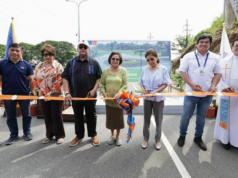Every great undertaking begins with an idea or in the mind is first conceived.
During the Subic-Clark Alliance for Development Council (SCADC) conference planning and workshop at Fontana last December, the idea of holding an international logistics summit at the Subic-Clark Corridor in 2010 was born. It was thought to showcase the great products and the big promise of the developing world-class mega-logistics hub and international services center in our Corridor before the major players involved in the business of logistics in the Asia Pacific Supply Chain.
Our study in SCADC shows that logistics is one of the fastest growing industries in the world. It impacts a country’s economic development as it links up the country to world trade and commerce, thereby opening new markets for its domestic products. The logistics market value worldwide in 2005 alone was recorded at 3.5 trillion US dollars, according to Logistics Asian Institute. No wonder then that the World Bank encourages developing countries to connect to global markets because such connection increases a nation’s economic capacity to compete, grow, attract investments, create jobs and reduce poverty.
Ang mga bagay na ito ang nagbunsod sa amin sa SCADC staff para hingin ang approval ng SCAD Council para simulan ang pagplano sa pagtataguyod ng isang INTERNATIONAL LOGISTICS SUMMIT 2010 dito sa Subic-Clark Corridor, at nagpapasalamat naman kami sa agarang pagbibigay ng supporta at approval ng Council sa balak na nabanggit.
Kung kayat ngayon nga ay ito ang isa sa mga proyekto na pinagkakaabalahan at pinaplano ng SCADC staff. Ito ay isang mahirap na proyekto, pero kailangang gawin sa dahilang dapat na makilala o maipakilala ang ating bansa na may kakayahang makilahok at makipagcompete in the logistics global market which is the fastest growing industry with logistics market value worldwide of 3.5 trillion US dollars and growing at the rate of 3 to 10% in the next 15 years.
Hindi madaling pasukin ang merkadong ito because the Philippines is at present not one of the major hubs of the interlinked international supply chain. Yung mga current major airlines, freight forwarders, 3PL players, shipping lines, and manufacturers prefer to locate and operate their businesses in neighboring countries like Singapore, China, Malaysia, Thailand and even Vietnam whose logistics hubs are all already actively engaged in the exchange, transport and delivery of products and services along the supply chain.
Hindi basta-bastang paghahanda ang kailangang gawin para mapasali sa supply chain. We must convince the major players in the logistics market in the Asia Pacific Rim that there already exist in the Subic-Clark Corridor the required logistics infra-structures they would need in the conduct of their business, and that there are other major ones that are in the process of construction and development and still some other infra projects that are already in the pipeline scheduled to be completed before the planned summit in 2010.
It is also important to convince the major players that laws, policies, rules and regulations are in place to reduce the cost of doing business here and make sure doing business is easy and safe and that they can conduct their business under a stable economic and business policy climate.
Equally important is to show that the SCAD Corridor, as a logistic hub, has sufficient business clusters that can (1) support the activities and supply the capital needs of logistics players; (2) provide adequate site-sizes for their warehouses; (3) become the center of operations for the manufacturers and other providers; and (4) avail of vast tracts of land for eco-industrial development.
The primary target audiences of the International Logistics Summit 2010 are those major players in the Asia Pacific Supply Chain and the logistics-related investors in the Greater Manila Area currently involved in the business of transport, supply, delivery, and distribution of goods, services, and people. There are hundreds of such major players in the field. Will they come to the summit?
It is a big challenge to make them come. It will all depend on what we can offer to meet their needs and requirements for locating here and for conducting a viable business operations at the SCAD Corridor.
But the bigger challenge the SCAD Council faces is: do we have time and resources to organize an event such as the envisioned international logistic summit? Considering the enormity of the tasks and activities involved, it is easy to give up the idea of holding such an event, for time indeed is short and the resources meager.
But we will try, and try hard. It is better to try than not to have tried at all. There’s excitement and joy in the former; only regret in the latter. For as lovers are wont to say: it’s better to love and not be loved than not to have loved at all. From the very act of loving springs happiness, even unrecompensed with similar feelings of affection; not to love at all leaves the heart unfulfilled and barren.
Having said all that, this surely I know: The agyu tamu spirit infuses our action in SCADC. We will, as we must, move on despite difficulties and not let a moment of doubt be a hinder in the way.
So, goodbye for now, dear readers, and see you again in the next issue. Agyu Tamu and Mabuhay!
By the way, I wrote this article Saturday, April 18. By the time it comes out in this paper next week, I will be in the US of A, together with my colleagues in the first part of our mission, to do a follow through on the successful results of that mission we made in February 26 – March 15, 2009. God bless our country and our people and you all.
During the Subic-Clark Alliance for Development Council (SCADC) conference planning and workshop at Fontana last December, the idea of holding an international logistics summit at the Subic-Clark Corridor in 2010 was born. It was thought to showcase the great products and the big promise of the developing world-class mega-logistics hub and international services center in our Corridor before the major players involved in the business of logistics in the Asia Pacific Supply Chain.
Our study in SCADC shows that logistics is one of the fastest growing industries in the world. It impacts a country’s economic development as it links up the country to world trade and commerce, thereby opening new markets for its domestic products. The logistics market value worldwide in 2005 alone was recorded at 3.5 trillion US dollars, according to Logistics Asian Institute. No wonder then that the World Bank encourages developing countries to connect to global markets because such connection increases a nation’s economic capacity to compete, grow, attract investments, create jobs and reduce poverty.
Ang mga bagay na ito ang nagbunsod sa amin sa SCADC staff para hingin ang approval ng SCAD Council para simulan ang pagplano sa pagtataguyod ng isang INTERNATIONAL LOGISTICS SUMMIT 2010 dito sa Subic-Clark Corridor, at nagpapasalamat naman kami sa agarang pagbibigay ng supporta at approval ng Council sa balak na nabanggit.
Kung kayat ngayon nga ay ito ang isa sa mga proyekto na pinagkakaabalahan at pinaplano ng SCADC staff. Ito ay isang mahirap na proyekto, pero kailangang gawin sa dahilang dapat na makilala o maipakilala ang ating bansa na may kakayahang makilahok at makipagcompete in the logistics global market which is the fastest growing industry with logistics market value worldwide of 3.5 trillion US dollars and growing at the rate of 3 to 10% in the next 15 years.
Hindi madaling pasukin ang merkadong ito because the Philippines is at present not one of the major hubs of the interlinked international supply chain. Yung mga current major airlines, freight forwarders, 3PL players, shipping lines, and manufacturers prefer to locate and operate their businesses in neighboring countries like Singapore, China, Malaysia, Thailand and even Vietnam whose logistics hubs are all already actively engaged in the exchange, transport and delivery of products and services along the supply chain.
Hindi basta-bastang paghahanda ang kailangang gawin para mapasali sa supply chain. We must convince the major players in the logistics market in the Asia Pacific Rim that there already exist in the Subic-Clark Corridor the required logistics infra-structures they would need in the conduct of their business, and that there are other major ones that are in the process of construction and development and still some other infra projects that are already in the pipeline scheduled to be completed before the planned summit in 2010.
It is also important to convince the major players that laws, policies, rules and regulations are in place to reduce the cost of doing business here and make sure doing business is easy and safe and that they can conduct their business under a stable economic and business policy climate.
Equally important is to show that the SCAD Corridor, as a logistic hub, has sufficient business clusters that can (1) support the activities and supply the capital needs of logistics players; (2) provide adequate site-sizes for their warehouses; (3) become the center of operations for the manufacturers and other providers; and (4) avail of vast tracts of land for eco-industrial development.
The primary target audiences of the International Logistics Summit 2010 are those major players in the Asia Pacific Supply Chain and the logistics-related investors in the Greater Manila Area currently involved in the business of transport, supply, delivery, and distribution of goods, services, and people. There are hundreds of such major players in the field. Will they come to the summit?
It is a big challenge to make them come. It will all depend on what we can offer to meet their needs and requirements for locating here and for conducting a viable business operations at the SCAD Corridor.
But the bigger challenge the SCAD Council faces is: do we have time and resources to organize an event such as the envisioned international logistic summit? Considering the enormity of the tasks and activities involved, it is easy to give up the idea of holding such an event, for time indeed is short and the resources meager.
But we will try, and try hard. It is better to try than not to have tried at all. There’s excitement and joy in the former; only regret in the latter. For as lovers are wont to say: it’s better to love and not be loved than not to have loved at all. From the very act of loving springs happiness, even unrecompensed with similar feelings of affection; not to love at all leaves the heart unfulfilled and barren.
Having said all that, this surely I know: The agyu tamu spirit infuses our action in SCADC. We will, as we must, move on despite difficulties and not let a moment of doubt be a hinder in the way.
So, goodbye for now, dear readers, and see you again in the next issue. Agyu Tamu and Mabuhay!
By the way, I wrote this article Saturday, April 18. By the time it comes out in this paper next week, I will be in the US of A, together with my colleagues in the first part of our mission, to do a follow through on the successful results of that mission we made in February 26 – March 15, 2009. God bless our country and our people and you all.



